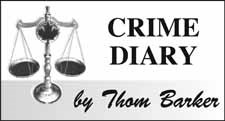This week, I wrote about a Crown appeal in what prosecutors called the "biggest drug trafficking case in Saskatchewan history and one of the most significant in national history."
Of course, Saskatchewan has always been a major haven for smugglers of all stripes. In the late 1800s, it was cattle rustling attracting famous American outlaws such as Butch Cassidy's "Hole-in-the-Wall Gang."
And most of us are aware of Moose Jaw's reputation as "Little Chicago" and that city's alleged connection to the notorious Al Capone during the prohibition years of the 1920s.
So, it was very interesting to me that on the same week of the Court of Appeal decision on such a momentous Saskatchewan cocaine case, I would discover Yorkton's own alleged connection to Capone.
You will forgive me if this story is common knowledge as I am a relative newcomer to our fair city. I was aware, of course, of the legacy of the Bronfman brothers and Seagram whiskey. And I had some vague idea they were involved in illicit liquor-running activities, but perhaps naive with respect to its extent.
While I was looking for interesting historical Yorkton crime stories I stumbled upon an excerpt from a book by Gord Steinke called Mobsters and Rumrunners of Canada.
The excerpt recounts a meeting between the Bronfmans and Capone in which they forged a relationship that suggests the illicit trade was perhaps far more responsible for the success of Seagram than I had previously thought.
It's not something the company plays up like, for example, Sleeman does. Perhaps Seagram should as it has fallen on some hard times while Sleeman's brilliant "Notoriously Good" campaign has been a massive success.
That connection between Capone and the Bronfman's was fascinating enough, but the excerpt also mentioned the murder four years earlier, on October 4, 1922, of Paul Matoff, Sam and Harry Bronfman's brother-in-law.
Fortunately, I have easy access to the entire collection of newspapers dating to the founding of Yorkton.
The October 6 edition of the Enterprise detailed how Matoff had delivered a cargo of liquor early in the evening on the third and proceeded to the C.P.R. station at Bienfait the next morning to despatch to Regina the $6,000 he had received.
"The boot-leggers followed him, shot him in cold blood through the station window, then entered the building and removing the money from his person holding the operator with their guns at bay until they secured the booty," the report read. "They then made their escape in a high-powered Cadillac car, passing the police patrol car at the next town while travelling at a rate of over 60 miles an hour."
The article goes on to suggest the motive for the murder was revenge.
"A couple of years ago the warehouse of which he was in charge was robbed," it said. "The criminals were traced to the U.S., captured and convicted, largely on Matoff's evidence. They swore then they would "get" him, and it is thought that Wednesday morning's murder is the result of the carrying out of this threat."
In light of this, one might think it would have given Sam and Harry pause about going into business with the likes of Capone, but given the general lawlessness of the time, perhaps they had little choice or the draw of what would amount to millions in today's dollars, according to Steinke, was just too tempting to pass up despite the risks.
It is an interesting anecdote in and of itself, but really it has but whetted my appetite to find out more about this fascinating time in Yorkton's history.
I understand the City's historian, Terri Lefebvre Prince, has a book out called The Whiskey Man, which I will have to track down at my earliest convenience.




